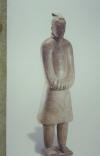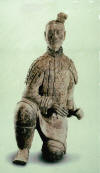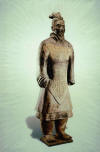|
"In 1974, excavations started at the site of the immense
burial mound of the First Emperor of Qin in Shaanxi
Province. For its construction, the ruler conscripted
many thousands of laborers and had the tomb filled with
treasure - a task that continued after his death. The
mound itself remains unexcavated, but pits uncovered around
it have revealed an astonishing collection of artifacts,
establishing the site as one of the past century's greatest
archaeological discoveries. Excavators have found more
than six thousand life-sized terracotta figures of soldiers
and horses - and more recently, bronze horses and
impressions of chariots. Replicating the emperor's
invincible hosts, they served as the immortal imperial
bodyguard deployed in trenches outside what researchers
believe is a vast underground funerary palace (as yet
unexcavated) designed to match the fabulous palace the
emperor occupied in life. The historian Sima Qian (136
- 85 B.C.) described both palaces, but scholars did not take
his account seriously until these statues came to light.
 (The still unexcavated
principal mound)
(The still unexcavated
principal mound)
Originally in vivid color, the
emperor's troops stood in long ranks and files, as if lined
up for battle. The terracotta army included cavalry,
chariots, archers, lancers and hand-to-hand fighters.
The style of the Qin warriors
blends formalism - simplicity of volume and contour,
rigidity, and frontality - with sharp realism of detail.
Set poses repeat with little or no variation, as if produced
from a single mold, but the figures exhibit subtle
differences in details of facial features, coiffures, and
equipment."
- Gardner's
Art Through The Ages,
11th edition, Vol. I, pp. 192 - 194

The soldiers were
buried in rows; the empty spaces visible in this image are
where wooden chariots originally would have been placed.
Many of the figures had been broken and burned, apparently
in an attack on the tomb during the collapse of the dynasty.

Each of the soldiers,
though made from general molds, were each individually
customized and brightly painted.
*****************************************************
Each of the three
figures below were excavated from the tomb of Qin-shi
Huangdi and are part of the Museum of Qin Shihuang. Each
of the figures was crafted from terracotta and brightly
painted. Note the variations in posture, facial
features, clothing, and implied personality and rank.
 Terracotta Stableman:
The terracotta stablemen were buried alongside terracotta
horses in the three full pits of the Qin emperor's
mausoleum. The main use for horses in the Qin era was
for the military (horse harnesses for agricultural work was
developed in Medieval Europe). Terracotta Stableman:
The terracotta stablemen were buried alongside terracotta
horses in the three full pits of the Qin emperor's
mausoleum. The main use for horses in the Qin era was
for the military (horse harnesses for agricultural work was
developed in Medieval Europe).
 Terracotta Archer: Archers were usually placed in double
rows so that while one row shot, the other row could
re-load. Archers could fire as many as three arrows
simultaneously with the crossbows used in the Qin dynasty.
Terracotta Archer: Archers were usually placed in double
rows so that while one row shot, the other row could
re-load. Archers could fire as many as three arrows
simultaneously with the crossbows used in the Qin dynasty.
 Terracotta General: In actual combat, the generals would be
in charge of a large bronze bell and a large wood and
leather drum. Beating the drum was a signal to
advance; ringing the bell would serve as a signal to
retreat.
Terracotta General: In actual combat, the generals would be
in charge of a large bronze bell and a large wood and
leather drum. Beating the drum was a signal to
advance; ringing the bell would serve as a signal to
retreat.
Information on the Terracotta figures adapted from:
Eternal China ed. Li Jian; Dayton Art Institute, 1998
pp. 73 - 93
|